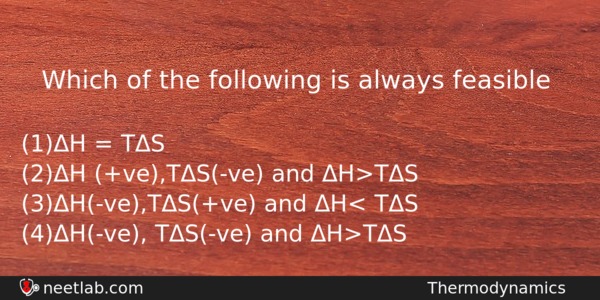| ⇦ | 
| ⇨ |
Which of the following is always feasible
Options
(a) ΔH = TΔS
(b) ΔH (+ve),TΔS(-ve) and ΔH>TΔS
(c) ΔH(-ve),TΔS(+ve) and ΔH< TΔS
(d) ΔH(-ve), TΔS(-ve) and ΔH>TΔS
Correct Answer:
ΔH(-ve),TΔS(+ve) and ΔH< TΔS
Explanation:
No explanation available. Be the first to write the explanation for this question by commenting below.
Related Questions: - Which of the following will not be soluble in sodium hydrogen carbonate
- Which of the following 0.1M solution will show maximum boiling point
- The mixture of n-hexane and n-heptane is an example of
- In Lassaigne’s test red colour precipitate is obtained which is due to formation
- Which of the following reaction is an example of nucleophilic substitution
Topics: Thermodynamics
(179)
Subject: Chemistry
(2512)
Important MCQs Based on Medical Entrance Examinations To Improve Your NEET Score
- Which of the following will not be soluble in sodium hydrogen carbonate
- Which of the following 0.1M solution will show maximum boiling point
- The mixture of n-hexane and n-heptane is an example of
- In Lassaigne’s test red colour precipitate is obtained which is due to formation
- Which of the following reaction is an example of nucleophilic substitution
Topics: Thermodynamics (179)
Subject: Chemistry (2512)
Important MCQs Based on Medical Entrance Examinations To Improve Your NEET Score
18000+ students are using NEETLab to improve their score. What about you?
Solve Previous Year MCQs, Mock Tests, Topicwise Practice Tests, Identify Weak Topics, Formula Flash cards and much more is available in NEETLab Android App to improve your NEET score.
Share this page with your friends

Leave a Reply